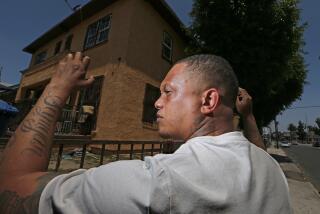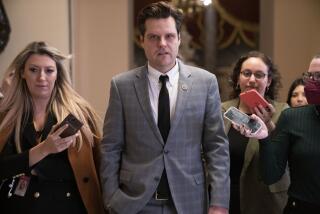Jury Orders Goetz to Pay $43 Million for Shooting
- Share via
NEW YORK — A civil court jury Tuesday declared that Bernhard Goetz acted recklessly and outrageously on a New York subway train 12 years ago and ordered him to pay $43 million in damages to a young black man he shot in the incident and left permanently paralyzed.
Goetz, who is white, shot Darrell Cabey with the last bullet in his unlicensed handgun after gunning down three other black youths on the train in December 1984. Goetz said the youths were about to rob him. The young men said they were only panhandling. The shootings rubbed raw racial nerves in New York and underlined throughout the nation the fears of people of all races about violent crime.
Goetz was acquitted of attempted murder in a criminal trial in 1987, but convicted of illegal gun possession. He served 250 days in jail.
There is little chance that Cabey, 30, who is confined to a wheelchair and brain-damaged, will collect the millions. Goetz, 48, has seen his income as a self-employed electronics expert plunge from $100,000 to about $20,000 a year since the shootings and has spent $60,000 in donations and about $250,000 of his own funds on legal costs.
Under state law, Cabey could collect 10% of Goetz’s earnings for the next 20 years.
Goetz was not in the courtroom when the verdict was announced. He reportedly took a subway home.
The Bronx jury of four blacks and two Latinos awarded Cabey $18 million in compensatory damages and $25 million in punitive damages. They found that Goetz had acted recklessly and outrageously, that his conduct exceeded reasonable bounds of decency and that he intended to cause Cabey severe emotional distress.
The civil trial was a weak echo of Goetz’s criminal trial, which drew a crush of reporters to Manhattan’s criminal court. Only a few people attended the civil proceedings.
Goetz sat quietly with his lawyer as the jury of four women and two men heard him pictured as a racist who carried an illegal gun and who in the past had used drugs.
Goetz’s attorney, Darnay Hoffman, argued that the subway gunman acted out of fear and not hatred. But he admitted that his client’s own words “damned him tremendously.”
Goetz, who did not testify at his criminal trial, took the witness stand, where he was sharply questioned by Cabey’s lawyer, Ronald Kuby.
Goetz said there were 20 people in the subway car “in addition to the four guys I shot.”
Goetz, who was mugged twice previously, said that after one of the youths asked him for $5, he was surrounded by them. He said he started shooting within 30 seconds of getting on the train.
Goetz said when he saw the smile on the face and the gleam in the eye of the youth asking him for money, “I snapped.”
“Does that mean you lost control?” Kuby asked.
“I would say at that point I was out of control,” Goetz answered.
“When I saw him smiling, I laid down my pattern of fire. You have a flood of emotions. . . . I was trying to get as many as I could.”
After finishing firing, he said he walked over to Cabey.
“He was one of the group. . . . I thought I may have winged him or something. His eyes were wide open. He was moving around like he was trying to get out of the seat. He did quite the wrong thing.”
Goetz said he then fired at Cabey, who was hit in the back, severing his spinal cord.
“If he wasn’t seriously injured, I was going to shoot him--yes,” Goetz told the jury.
In his closing arguments, Hoffman asked why Kuby did not call the three other people shot by Goetz as witnesses.
“Why didn’t they come to help a brother? No evidence was introduced this wasn’t a robbery,” he said.
Hoffman himself called only two witnesses: Newsday columnist Jimmy Breslin, who said Cabey told him the four men on the subway planned to rob Goetz because he looked like “easy bait,” and a psychiatrist who testified that Goetz acted out of fear and went on “autopilot” because he had been mugged before.”
But Kuby argued that Cabey was minding his own business and that a robbery was not underway when Goetz started shooting.
More to Read
Sign up for Essential California
The most important California stories and recommendations in your inbox every morning.
You may occasionally receive promotional content from the Los Angeles Times.













